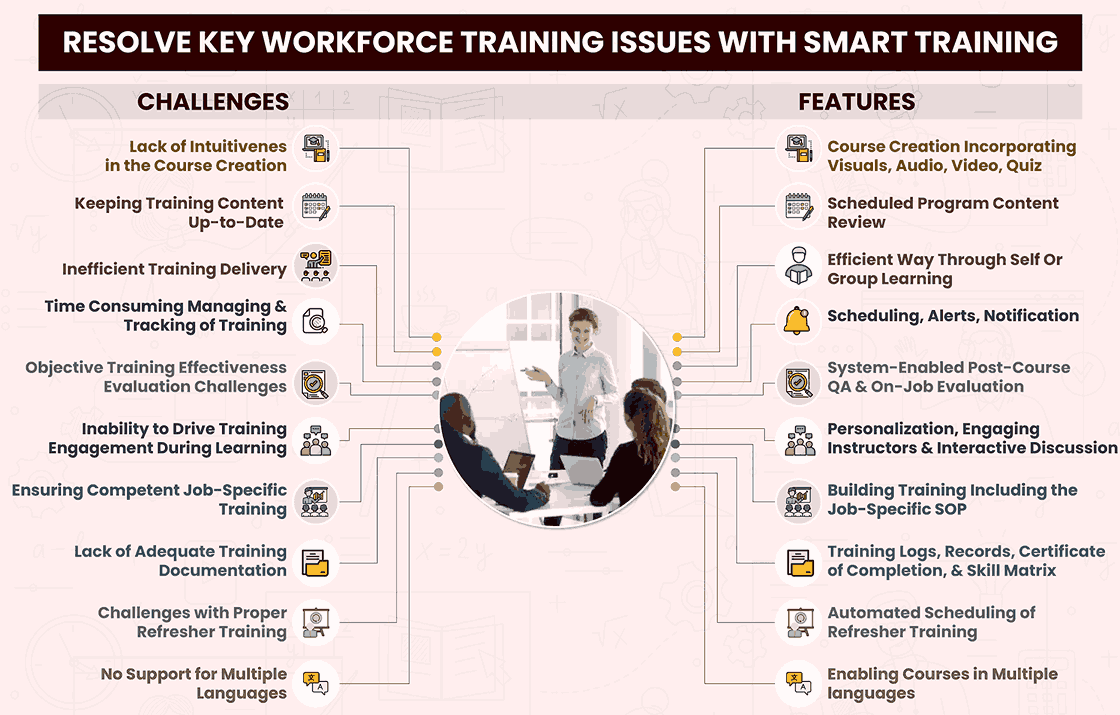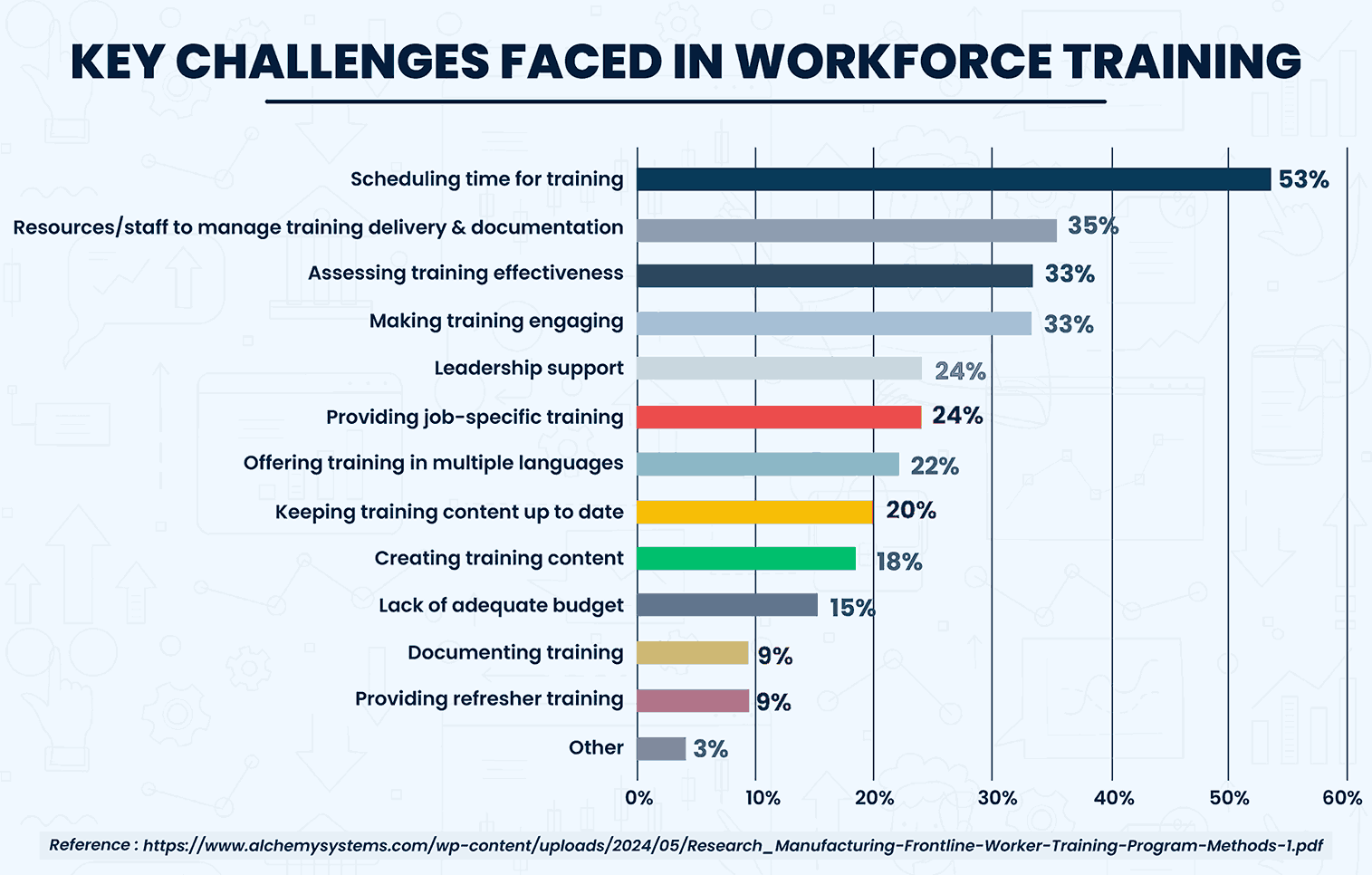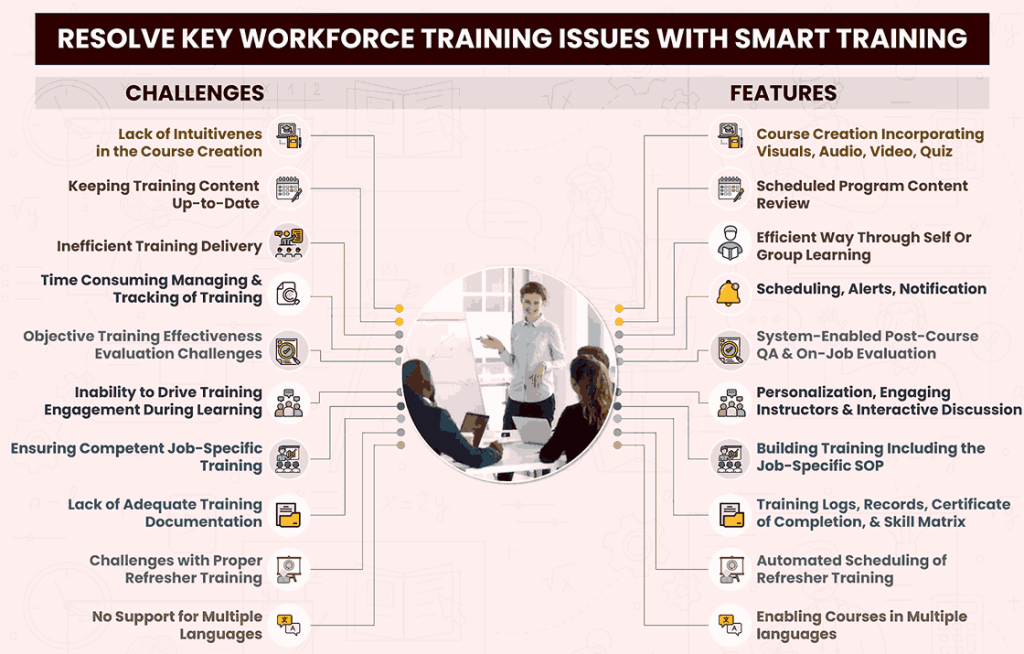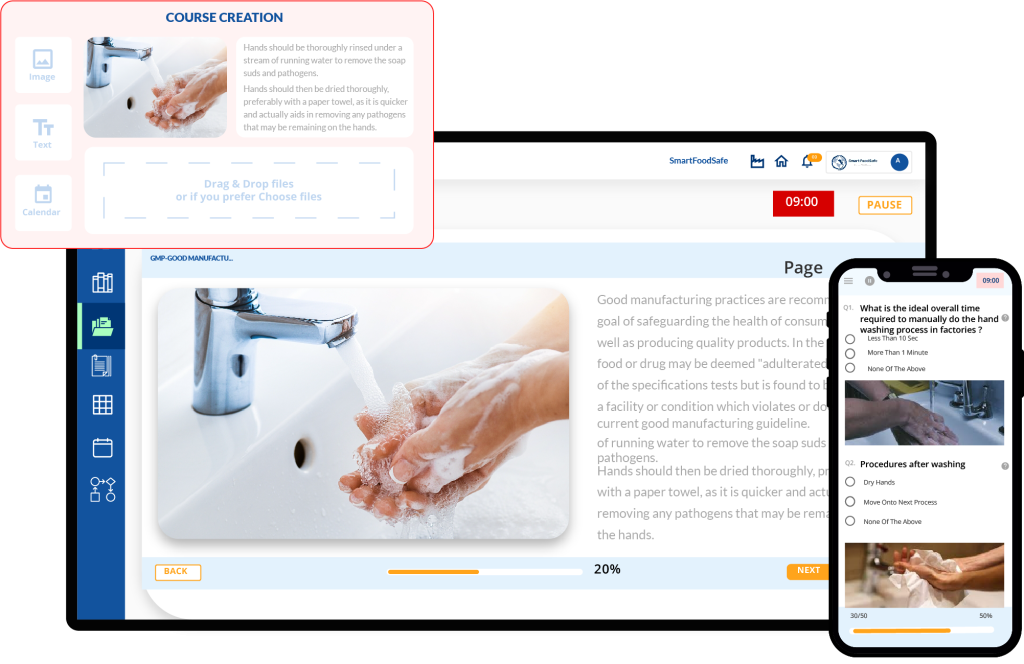
In the ever-evolving landscape of today’s workplace, ensuring your team is well-trained is more critical than ever. Yet, organizations continually face a myriad of challenges in workforce training that can hinder progress and stifle growth. Let’s delve into these common issues and uncover practical solutions that will empower your team and drive success.
In early 2024, the “Survey of Frontline Employee Training Programs” was conducted by Intertek Alchemy, in which 1,028 individuals participated, attempting 57 questions related to the nature of training and workforce development programs within their manufacturing facilities. This survey presented one of the largest, most comprehensive research on manufacturing workforce training programs.
Among the results of this survey, was a section concluding a dozen commonly reported challenges by training leaders in manufacturing. Let’s examine these challenges and draw an understanding of the plausible solutions that can be implemented for elevated workforce training outcomes.
Impact of Workforce Training
Training is a systematic process designed to enhance employees’ skills, knowledge, and competency necessary for them to perform their duties efficiently within the organization. The survival of any organization in a competitive society depends on its ability to train its human resources to be creative, innovative, and inventive. Training improves employees’ performance and is expected to yield positive changes that improve the quality of their work.
Workforce training is not just an operational necessity but a strategic imperative. By investing in the development of employees, organizations can foster a motivated, skilled, and competent workforce capable of driving performance and achieving long-term success. As the competitive landscape continues to evolve, the emphasis on continuous learning and development will remain a cornerstone of organizational excellence and sustainability.
Tackling the Key Challenges Faced in Workforce Training

⇒ Scheduling Time for Training (52%)
Challenge: Scheduling time for training is the most significant challenge. Finding suitable time slots for training sessions that do not disrupt regular operations is a significant challenge. Balancing training schedules with daily tasks often leads to conflicts and delays.
Solution: To address this, organizations can integrate microlearning into their training programs. Microlearning breaks down training content into small, manageable modules that can be completed in short time frames, making it easier for employees to fit training into their schedules. Offering flexible training options, such as on-demand e-learning and virtual training sessions, allows employees to learn at their own pace and at times that are convenient for them.
⇒ Resources/Staff to Manage Training Delivery & Documentation (35%)
Challenge: Adequate staffing and resources are critical for delivering training and maintaining accurate documentation. Many organizations struggle with allocating sufficient personnel to manage these tasks proficiently.
Solution: Leveraging Learning Management Systems (LMS) can streamline the training delivery and documentation process. An LMS can automate administrative tasks, track employee progress, and generate reports, reducing the burden on HR and training departments. Additionally, investing in professional development for training staff ensures they are equipped with the skills needed to manage and deliver training programs.
⇒ Assessing Training Effectiveness (33%)
Challenge: Measuring the impact and effectiveness of training programs is complex. Organizations often lack the tools and methods to evaluate whether the training meets its objectives and translates into improved performance.
Solution: Implementing a robust evaluation framework is key to assessing training effectiveness. This can include pre- and post-training assessments, employee feedback surveys, and performance metrics analysis. Using Kirkpatrick’s Four-Level Training Evaluation Model, organizations can measure reaction, learning, behavior, and results to determine the impact of training programs and identify areas for improvement.
⇒ Making Training Engaging (32%)
Challenge: Keeping employees engaged during training sessions is challenging. Traditional training methods can be monotonous, leading to disengagement and poor retention of information.
Solution: Incorporating interactive elements such as gamification, simulations, and real-world scenarios can make training more engaging. Gamification, in particular, adds a competitive element to training, encouraging employees to participate and perform better. Using multimedia content like videos, infographics, and interactive quizzes can cater to different learning styles and keep employees interested.
⇒ Leadership Support (25%)
Challenge: Gaining consistent support from leadership is critical for the success of training programs. Without backing from higher management, training initiatives may lack the necessary resources and prioritization.
Solution: Involving leaders in the training process, such as having them participate in sessions or share their experiences, can underscore the importance of training and encourage a culture of continuous learning. To secure leadership support, it is essential to demonstrate the ROI of training programs. Presenting data on how training improves performance, productivity, and employee retention can help in gaining buy-in from leadership.
⇒ Providing Job-Specific Training (23%)
Challenge: Tailoring training programs to specific job roles ensures relevance and effectiveness. However, creating customized training content for diverse roles within an organization can be resource-intensive.
Solution: Conducting a thorough needs assessment can help in identifying the specific skills and knowledge required for different roles. Developing customized training programs that address these needs ensures that employees receive relevant and practical training. Partnering with industry experts and using real-life case studies can also enhance the relevance and outcome of job-specific training.
⇒ Offering Training in Multiple Languages (23%)
Challenge: In multilingual workplaces, providing training in various languages is essential to ensure comprehension and inclusivity. This requires additional resources and expertise.
Solution: Utilizing translation services and e-learning platforms that support multiple languages can help overcome this challenge. Creating training content with cultural sensitivity in mind and ensuring it is accessible to all employees regardless of their language proficiency is crucial. Providing language support resources, such as glossaries and translation tools, can also aid in better understanding and retention of training material.
⇒ Keeping Training Content Up to Date (21%)
Challenge: Rapid changes in industry standards and practices necessitate constant updates to training content. Ensuring that training materials are current and relevant can be a continuous challenge.
Solution: Regularly reviewing and updating training content is essential to keep it aligned with industry trends and organizational changes. Collaborating with subject matter experts to validate and update content can ensure its accuracy and relevance. Using digital platforms allows for easier and quicker updates to training material.
⇒ Creating Training Content (18%)
Challenge: Developing high-quality training materials requires time, expertise, and creativity. Many organizations find it difficult to produce engaging and informative content consistently.
Solution: Partnering with external training providers or consultants can help in developing high-quality content. Using off-the-shelf e-learning content that can be customized to meet specific organizational needs can be a cost-effective solution. Encouraging employees to contribute to content creation by sharing their knowledge and experiences can also enrich training material.
⇒ Lack of Adequate Budget (15%)
Challenge: Budget constraints can limit the scope and quality of training programs. Insufficient funding often leads to compromises in training delivery, materials, and infrastructure.
Solution: Prioritizing training initiatives based on organizational goals and needs can help in making the most of the available budget. Exploring cost-effective training methods, such as online courses and webinars, can also reduce expenses. Applying for grants and subsidies for workforce training can provide additional financial support.
⇒ Documenting Training (10%)
Challenge: Maintaining thorough and accurate records of training activities is vital for compliance and performance tracking. However, documentation can be time-consuming and prone to errors.
Solution: Using digital documentation tools and an LMS can simplify the process of recording and storing training data. Automating documentation tasks and generating digital certificates of completion can ensure accurate and efficient record-keeping. Implementing standardized documentation procedures can also enhance consistency and compliance.
⇒ Providing Refresher Training (10%)
Challenge: Regular refresher training is necessary to keep skills and knowledge up to date. Scheduling and delivering these sessions without disrupting workflow remains a significant hurdle.
Solution: Scheduling periodic refresher training sessions and incorporating them into the annual training calendar can ensure consistency. Using e-learning modules for refresher training allows employees to revisit content at their convenience. Tracking employees’ training history and performance can help in identifying when refresher training is needed.
⇒ Other Challenges (3%)
Challenge: Various other challenges, such as cultural differences and technological limitations, also impact the success rate of workforce training programs.
Solution: Addressing these miscellaneous challenges requires a tailored approach based on the specific issues identified. Conducting regular feedback sessions with employees can help identify and address any additional training-related challenges they face.
Tackling workforce training challenges requires an organized and multifaceted approach. By leveraging technology, customizing training programs, securing leadership support, and ensuring regular updates and assessments, organizations can create competent and engaging training programs. Addressing these challenges not only augments employee performance and satisfaction but also contributes to the overall productivity and competitiveness of the organization.
Smart Training: One-Stop Solution to Empower Workforce Training Processes
Smart Training, a digital training management solution offered by Smart Food Safe, presents a set of features, specifically designed to address the myriad challenges organizations face in their training protocols. Smart Training accomplishes this by:
| Workforce Training Challenges We Solve | Features of Smart Training |
|---|---|
| Creating an Intuitive Course | Course Creation Incorporating Visuals, Audio, Video, Quiz, and Presentation |
| Maintaining Training Content Up-to-Date | Periodic Program Content Review |
| Training Delivery Management | Easy to Access Self Or Group Learning |
| Managing and Tracking of Training Completion | Scheduling, Alerts, Notification |
| Training Effectiveness Evaluation | Post-Course QA and On-Job Evaluation |
| Driving Training Engagement | Personalization, Engaging Instructors, and Interactive Discussions |
| Training Documentation | Training on Standard Operating Procedures |
| Job-Specific Training | Training Logs, Records, Certificate of Completion, and Skill Matrix |
| Refresher Training Provision | Automated Scheduling of Refresher Training |
| Training in Multiple Languages | Multilingual Support |
In this way, Smart Training contributes to fostering a culture of continuous learning and development within the organization, leading to improved workforce performance and output.




